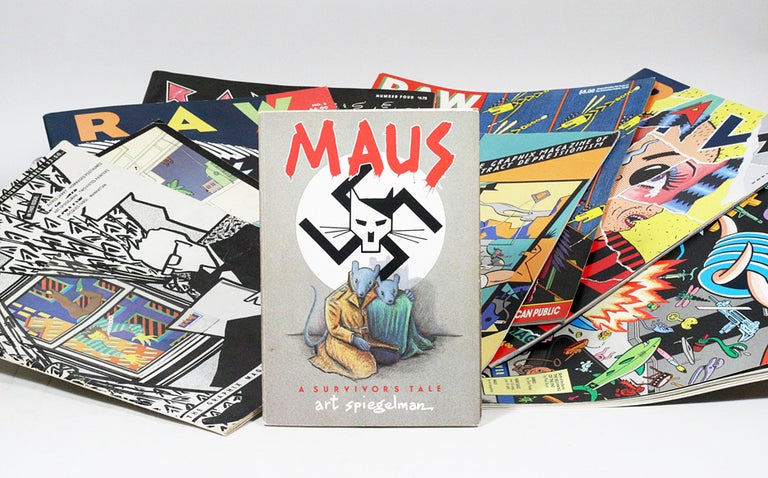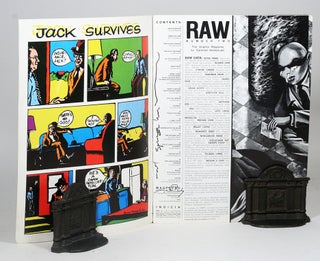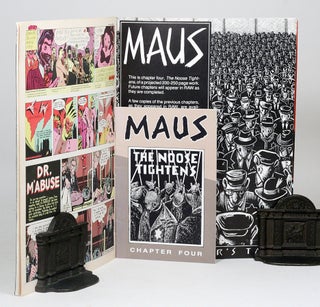Maus. A Survivor's Tale.
“It continues to be the greatest graphic novel ever written.” -Chris Ware, on Maus
FIRST BOOK EDITION, WITH LARGE SIGNED INK DRAWING BY SPIEGELMAN; WITH THE FIRST EIGHT ISSUES OF RAW MAGAZINE – SIGNED BY SPIEGELMAN IN SEVEN ISSUES – WHERE THE COMPLETE FIRST PART OF MAUS FIRST APPEARED.
“Art Spiegelman’s father Vladek was a Polish Jew who survived the Holocaust. When Spiegelman told his father’s story in Maus, he depicted all the Jews as mice and all the Nazis as cats. Strangely, the cartoonish conceit doesn’t trivialize the story, it makes it viscerally real — it strips away our practiced indifference to an all too familiar story. Those mice are more human than most people. Alongside his father’s tale Spiegelman lovingly but honestly depicts his own relationship with his father, who has aged into a difficult, prickly, fearful man. Maus won a Pulitzer in 1992, a landmark event in the history of the medium — its sheer power forced the mainstream world to take comics seriously” (Lev Grossman, Time, “Top 10 Graphic Novels”, March 5, 2009).
The first chapter of Maus first appeared in December 1980 in the second issue of the magazine Raw, an indie magazine founded by Spiegelman and his wife Francoise Mouly. A new chapter appeared in each issue until 1991 when the magazine folded. (All but the final chapter originally appeared in Raw).
“After ‘Maus’ comics had appeared in the biannual RAW for about five years, Spiegelman pitched the work to publishers — meeting little enthusiasm. Then, in 1985, Ken Tucker’s essay for the New York Times hailed the work-in-progress as ‘a remarkable feat of documentary detail and novelistic vividness,’ and it quoted a Library of Congress graphic-art curator who said that the cutting-edge ‘Maus’ returned ‘an excitement that has been lost in comic art.’
“‘The result,’ Spiegelman says, ‘was all of a sudden, Pantheon was interested in putting out the first volume.’ It landed in August 1986, inspiring a generation of up-and-comers who held no prejudices about the comics form” (Michael Cavna, The Washington Post, “Why ‘Maus’ remains ‘the greatest graphic novel ever written,’ 30 years later,” August 11, 2016).
Note: This rare true first book edition of Maus, issued in 1986, is not to be confused with the later (much more common) 1991 edition released to coincide with the publication of part II (not included here).
Raw Magazine. New York: Raw Books & Graphics, 1980-1986. Large (approx. 10.5x14.5 inches) illustrated wrappers. Eight issues. In outstanding condition with all inserts. In addition to seven issues signed by Spiegelman, four issues are signed by François Mouly, six by Gary Panter, and one by Charles Burns. Each part of Maus is included as an inserted booklet in each issue with a large descriptive illustrated page surrounding each booklet.
Maus. A Survivor’s Tale. New York: Pantheon Books, 1986. Octavo, original wrappers. Near-fine with only slight general wear. Ink drawing by Spiegelman on epigraph page.
A RARE COLLECTION OF AN IMPORTANT AND GROUNDBREAKING WORK.
Check Availability:
P: 212.326.8907
E: info@manhattanrarebooks.com












